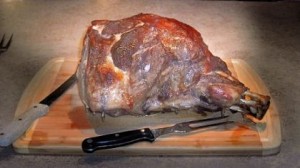Great story from Arlene Burnett Pittsburgh Post-Gazette and recipe review from Ham: An Obsession with the Hindquarter by Bruce Weinstein and Marc Scarbrough. (We have their book on Goat, which is also a fun read and a great cookbook)
have their book on Goat, which is also a fun read and a great cookbook)
“A few weeks before Easter when I was about 12, my father declared, ‘I’m tired of ham and turkey. This Easter we’re going to have fresh ham.’
Fresh ham? We always had ham and I assumed it was fresh.
My dad went on to explain the process of curing a ham and the difference between that and fresh. I guess he thought I wasn’t getting it, so he summed it up by saying, fresh ham is just like a pork roast but better because it has a big bone and bones always make the meat taste better.”
Ingredients
8- to 10-pound bone-in fresh ham, preferably from the shank end, any rind removed
1 teaspoon sugar
1/2 teaspoon ground allspice
1/2 teaspoon ground cloves
1/2 teaspoon grated nutmeg
1/2 teaspoon salt
1/2 cup maple syrup
Put the ham in a large roasting pan, preferably one that’s shiny enough to reflect lots of ambient heat and not so flimsy that it tips when you pick it up. Set the oven rack as high as it can go and still afford the ham at least 2 inches of head space. Preheat the oven to 325 degrees.
Mix sugar, cinnamon, allspice, cloves, nutmeg and salt in a small bowl. Smooth the spice mixture all over the ham’s external surface. Work it down into some of the crevices but be careful to avoid any deep-tissue massage. A ham is a complex structure of muscle groups — too much massage and they can come apart like Goldie Hawn in “Death Becomes Her.”
Cover the whole kit and caboodle with aluminum foil, shove it in the oven, and leave it alone for 31/2 hours, while you go do whatever it is you do when a big, sweating hunk of meat is roasting in your oven.
Peel off the aluminum foil. Baste the ham with about half the maple syrup, preferably using a basting brush. Take it easy so you don’t knock off the spice coating. Use small strokes — think Impressionism, not Abstract Expressionism. Or just dribble the syrup off a spoon.
Continue roasting the ham, uncovered this time, basting every 15 minutes or so with more maple syrup as well as any pan drippings, until an instant-read meat thermometer inserted into the thickest park of the meat without touching bone registers 170 degrees, about 11/4 hours. If it starts to singe or turn too dark, tent it loosely with foil, uncovering it just at the last to get it back to crunchy crisp.
Transfer the ham to a cutting board and let it rest at room temperature for 15 minutes before carving. Serves about 12 or more.
Note from Arlene & Bruce:
I followed the authors’ advice and cooked my pork until it reached 170 degrees. Here’s the authors’ explanation: “We’ve found that ham, unlike pork chops, is still a bit tough at 160 degrees. The reason? By 160 degrees most of the natural juice has been squeezed out of the tightening planes of the meat fibers, but that juice hasn’t yet been replaced by collagen and connective tissue melt, both of which happen at just about 160 degrees. We find that 170 degrees is a better marker; the collagen has melted infusing those dry meat fibers again with juice, thereby yielding a more tender slice on the dinner plates.”
